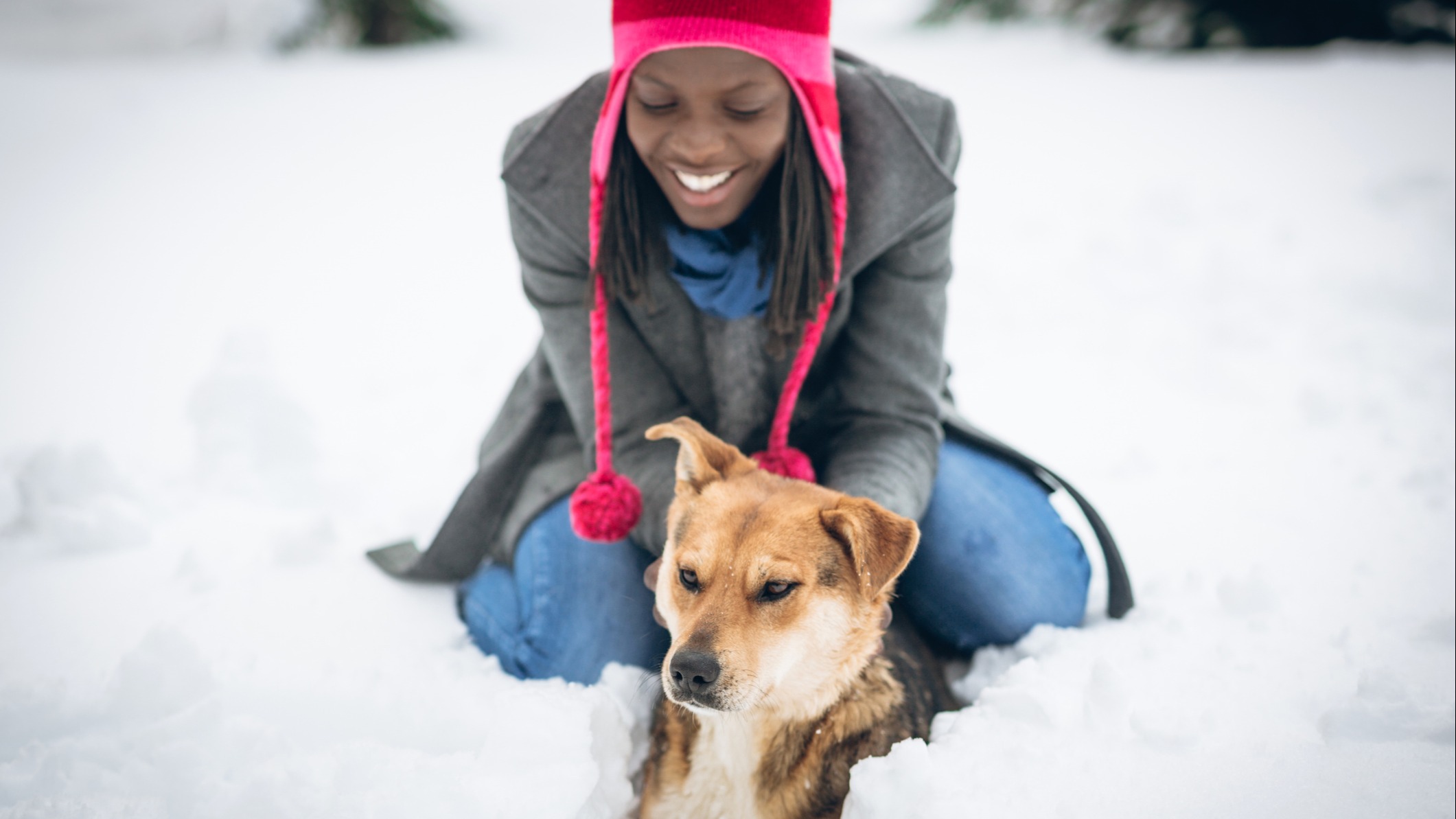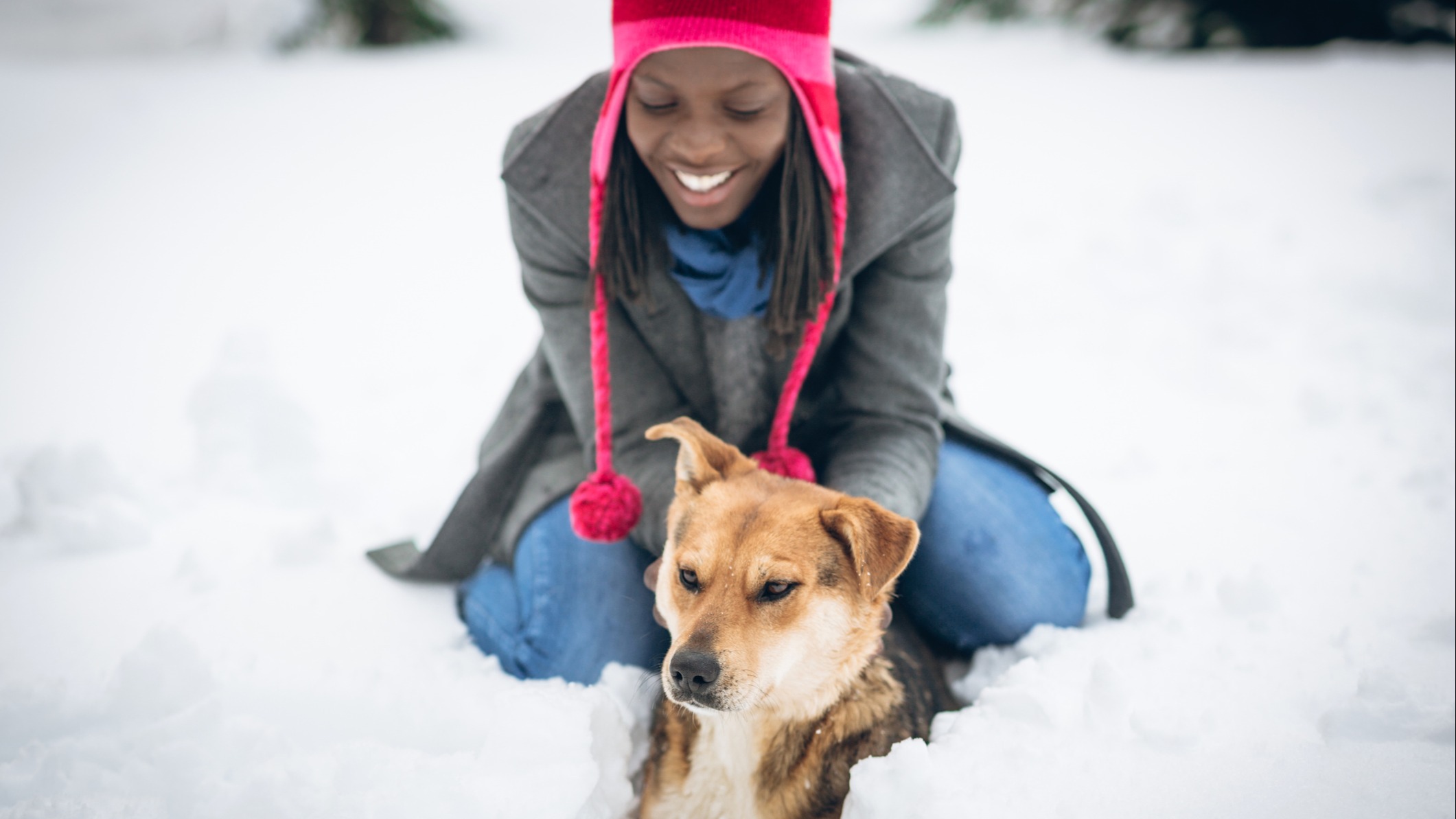
Dogs may have fur coats, but that doesn’t necessarily mean they’re protected from all the elements of winter. As the temperatures drop and snow and ice removal products are put into use, it’s important for pet parents to take the proper precautions to keep their pets healthy and safe.
A good rule of thumb to follow is, “If it’s too cold for you, it’s likely too cold for your pet,” Diane Ashton, director of communications for St. Hubert’s Animal Welfare Center, tells LittleThings. “Similar to humans, pets are also susceptible to frostbite and hypothermia,” she notes.
Dr. Gary Richter, veterinarian and founder of Ultimate Pet Nutrition, adds that “many dogs are actually more well-equipped than humans are at keeping themselves warm in the colder temperatures. However, the mid-40s to 50s [Fahrenheit] is a good range of temperature to limit time outside for dogs without thick, winter coats.”
When it comes to those winter coats, Richter tells LittleThings, “While it’s OK to cut your dog’s hair in the winter to keep it from getting matted or unkempt, shaving your dog in the winter is generally not the best idea. Your dog’s fur can act as an insulator, helping them stay warm. This especially applies to dogs with winter coats, like huskies.”
Ashton suggests, “If your dog is short-haired, consider getting him a coat or sweater with coverage from the base of the tail to the belly.”
When it’s time to go for a walk, take precautions to keep your pet safe from rock salt. Richter warns, “Ice, snow, and rock salt can get packed in between your dog’s paw pads and fur, which can cause irritation or even injury at times. Always check their paws when they come inside for this. Washing your dog’s paws when they come inside and wiping them down is a good way to avoid this.”
Ashton suggests, “Protect your pet’s paws from irritation caused by salt and other chemicals by applying products such as petroleum jelly or Musher’s Secret before heading outside. These products create a wax-like barrier that hydrates and safeguards your pet’s paws from the elements. If your pet will allow them, boots provide even more coverage and can also prevent sand and salt from getting lodged between bare toes.”
Pet parents should opt for pet-friendly ice melts like Safe Paw.
Rock salt isn’t the only dangerous thing you might encounter while on your walk. Richter says pet parents should also beware of antifreeze: “If you live in an area where antifreeze is commonly used in car engines, make sure you keep your dog away from any spills on roads, sidewalks, or driveways. You can spot antifreeze puddles by their greenish color. Believe it or not, antifreeze can actually taste good to dogs and cats, but it’s highly toxic, so it’s important to keep them away from exposure.”
The ASPCA notes that a key ingredient found in most antifreeze is ethylene glycol, which is highly toxic in small amounts and affects the nervous system and kidneys. Early signs of ingestion may be missed, and your pet could become severely ill in just six to 12 hours.
Here are signs of ethylene glycol/antifreeze poisoning according to the ASPCA:
• Unsteadiness on the feet
• Vomiting
• Depression
• Increase in thirst and urination
• Loss of appetite
• Seizures
If your pet does ingest this chemical, immediately take them to the nearest animal hospital. It’s also good to be aware of other household items where ethylene glycol may be, including printer and pen inks. So keep an eye on your pen-eating pooch!
Another way to avoid hazardous circumstances with your pet while outside in the winter is to keep your dog on a leash. “Never let your dog off the leash on snow or ice, especially during a snowstorm,” says Ashton. “Dogs frequently lose their scent in snow and ice and easily become lost. More dogs are lost during the winter than during any other season.”
When you return from your walk, Ashton instructs, “Wash your pet’s feet and abdomen with warm water and towel-dry to prevent further irritation from salt, ice, and other harmful chemicals. Check for any redness and cracks on the paw pad and in between the toes.”
Puppy parents will find themselves in and out very often as they house-train. Adrienne Carson, CPDT and behavior consultant and director of training and behavior at St. Hubert’s Animal Welfare Center, tells LittleThings, “Snow can be distracting. If your puppy doesn't go potty when you are sure they need to, keep them close to you (on a leash indoors) when you go back inside. At the slightest hint of them needing to go, get back outside and try again. Repeat until you have success!”
Because some pups may be less thrilled about the snow, Carson suggests bringing treats to use as a reward when they have success. Pet parents can also “shovel a path straight to your chosen potty spot. Clear an area large enough for your puppy to move around and get down to business.”
If your dog enjoys playing in the backyard, be sure to limit their time outside as well. Richter points out, “If you keep water bowls outside, keep in mind that water can freeze as well. Heated water bowls and heated dog houses can be good options for wintertime.”
Some states, like New Jersey, require proper shelter if animals will be outside for longer than 30 minutes in freezing conditions.
PetMD lists signs of frostbite in dogs as “the skin becoming very pale with a bluish-white hue due to a lack of blood flow. Ice may also form around the affected area. When the area is touched, it feels very cold or brittle, and may be painful. When the body part is warmed and blood flow returns, the skin becomes red and there is swelling accompanied by peeling. This is very painful and may lead to blisters or skin ulcers. As dog frostbite progresses, the area becomes blackened, which indicates death of the local tissue.”
If you suspect your dog might be suffering from frostbite, call your veterinarian. While you can provide immediate care at home, such as placing warm towels on your dog, PetMD also states that your pet might require pain medication and antibiotics.
If you spot an animal in your neighborhood that has been left outside for an extended period of time in extreme conditions, the Humane Society of the United States encourages you to speak out: “If you encounter a pet left in the cold, politely let the owner know you're concerned. Some people genuinely don’t know the risk that cold weather poses to their pets or livestock and will be quick to correct any problems you address. If someone you raise these concerns with responds poorly or continues to neglect their animals, follow our steps on reporting winter neglect.”

Exercising your pets on walks and romping in the snow together keeps your fur-family member healthy and happy. After a safe session, enjoy your time warming up together, safe and snuggly inside your home.




